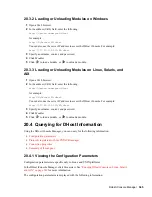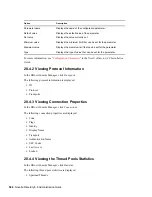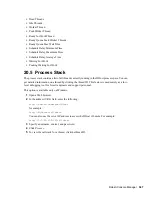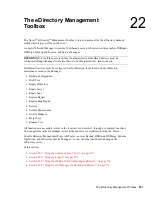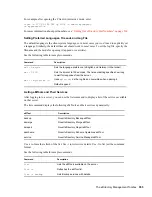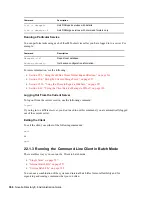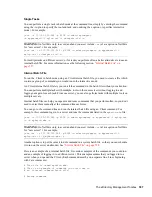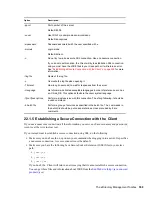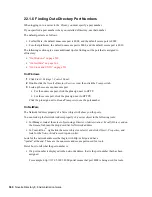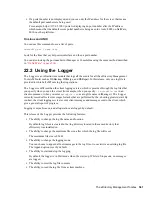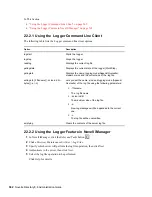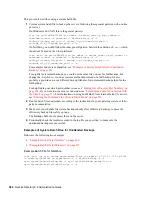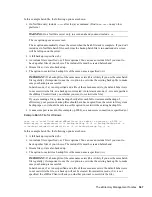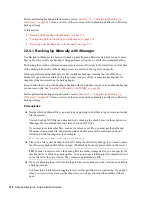
The eDirectory Management Toolbox
557
n
ov
do
cx (e
n)
22
Ju
n
e 20
09
Single Tasks
You can perform a single task in batch mode at the command line, simply by entering the command
using the -t option to specify the tool and task, and omitting the -i option (-i specifies interactive
mode). For example,
java -s 137.65.123.244 -p 8008 -u admin.mycompany
-w mypassword -l mylog.txt -t dsrepair.rld -n
WARNING:
On NetWare only, to avoid an abend you
must
include
-ns
(a Java option on NetWare
for “new screen”). For example,
java -ns -s 137.65.123.244 -p 8008 -u admin.mycompany -w mypassword -l
mylog.txt -t dsrepair.rld -n
For multiple tasks on different servers, or for tasks you perform often, a better alternative is to use an
internal batch file. For more information, see the following section,
“Internal Batch File” on
page 557
.
Internal Batch File
To run the Client in batch mode using an Client internal batch file, you need to create a file which
contains a group of commands you would run in the interactive mode.
An Client internal batch file lets you run all the commands in the batch file without your attention.
You can perform multiple tasks with multiple tools on the same server without logging in and
logging out again for each task. From one server, you can also perform tasks with multiple tools on
multiple servers.
Internal batch files can help you organize and reuse commands that you perform often, so you don't
need to enter them manually at the command line each time.
You can go to the command line and run the internal batch file using an Client command. For
example, this command logs in to a server and runs the commands listed in the
mybatch.mbx
file:
java -s 137.65.123.244 -p 8008 -u admin.mycompany -w mypassword -l mylog.txt
-o -b mybatch.mbx -n
WARNING:
On NetWare only, to avoid an abend you
must
include
-ns
(a Java option on NetWare
for “new screen”). For example,
java -ns -s 137.65.123.244 -p 8008 -u admin.mycompany -w mypassword -l
mylog.txt -o -b mybatch.mbx -n
Another option is to put the same kind of command in a system batch file, so that you can schedule
it to run on the server unattended. See
“System Batch File” on page 558
.
Here is an example of an internal batch file. It contains examples of the commands you could run
and an example of logging in to a different server. This example assumes that you logged in to a
server when you opened the Client. (Each command must be on a separate line. Lines beginning
with # are comments.)
# This file is named mybatch.mbx.
# This is an example of commands you could use in
# an internal command batch file.
# Backup commands
Summary of Contents for EDIRECTORY 8.8 SP5
Page 4: ...4 Novell eDirectory 8 8 Administration Guide novdocx en 22 June 2009...
Page 72: ...72 Novell eDirectory 8 8 Administration Guide novdocx en 22 June 2009...
Page 118: ...118 Novell eDirectory 8 8 Administration Guide novdocx en 22 June 2009...
Page 130: ...130 Novell eDirectory 8 8 Administration Guide novdocx en 22 June 2009...
Page 188: ...188 Novell eDirectory 8 8 Administration Guide novdocx en 22 June 2009...
Page 222: ...222 Novell eDirectory 8 8 Administration Guide novdocx en 22 June 2009...
Page 240: ...240 Novell eDirectory 8 8 Administration Guide novdocx en 22 June 2009...
Page 264: ...264 Novell eDirectory 8 8 Administration Guide novdocx en 22 June 2009...
Page 290: ...290 Novell eDirectory 8 8 Administration Guide novdocx en 22 June 2009...
Page 322: ...322 Novell eDirectory 8 8 Administration Guide novdocx en 22 June 2009...
Page 540: ...540 Novell eDirectory 8 8 Administration Guide novdocx en 22 June 2009...
Page 548: ...548 Novell eDirectory 8 8 Administration Guide novdocx en 22 June 2009...
Page 616: ...616 Novell eDirectory 8 8 Administration Guide novdocx en 22 June 2009...



